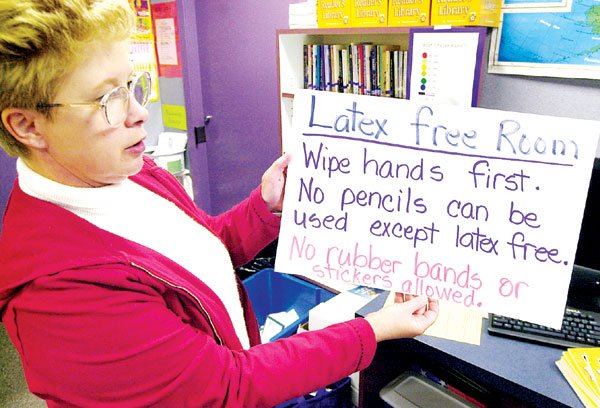GILROY
– Don’t bring balloons to Antonio Del Buono Elementary School.
The decorations are banned, along with certain types of paint.
By Lori Stuenkel
GILROY – Don’t bring balloons to Antonio Del Buono Elementary School. The decorations are banned, along with certain types of paint.
Certain brands of pencils are required – those with a latex-free eraser – and teachers do not reward students with colorful stickers. Even the swings on the playground are required to have special rubber-free seats.
Why? Because for one Del Buono student, these measures are a matter of life and death. If she comes into contact with the proteins in naturally-occurring latex, she will go into anaphylactic shock, with a rapid pulse, low blood pressure, dizziness and difficulty breathing.
“It is a constant thing. … We have a three-minute window between life and death,” said the mother of the student, whose name has been withheld because she is in the process of being adopted.
Latex, which comes from the milky sap of the rubber tree, causes allergic reactions in less than 6 percent of the general population, according to the National Institute for Occupational Safety and Health.
However, the incidence increases among those, like the Del Buono student, who have spina bifida – the incomplete development of the brain, spinal cord and/or protective coverings of those organs. Up to 73 percent of people with spina bifida are allergic to latex, according to the Spina Bifida Association of America. The higher occurrence is attributed to the frequent contact spina bifida patients have with latex medical equipment.
“We’ve totally re-organized our life, and it’s just the way we live,” her mother said. “She cannot be around a newspaper, because the newsprint is latex. She can’t ride on a school bus, because it’s full of latex.”
The fifth-grader’s allergy presents a unique challenge for the school district, which must provide her with a safe environment by removing latex hazards.
“Everybody’s really good about it, especially the kids. The parents are really understanding,” said Tammy Gabel, principal of Del Buono.
Students and parents are informed of the student’s latex allergy at the beginning of each year. Students in the girl’s class wash their hands before entering the classroom to remove latex proteins from rubber balls used during recess.
They are happy to oblige, said District Nurse Eileen Obata, who helps brief the girl’s teachers.
“We’ve had very supportive students, parents and staff,” she said. “They have lots of questions, and it raises a lot of concerns in the beginning. … But, overall, I’ve had nothing but positive responses.”
School must be safe
Districts are required under the Individuals with Disabilities Education Act (IDEA) to accommodate students with special needs and make the entire school campus a safe place for those with environmental allergies.
“We’re obligated to make accommodations for any student,” said Joe Guzicki, the district’s coordinator of student services. “It really depends on the severity, and we look at those cases individually.”
For the Del Buono student, that means the district has made significant modifications to some buildings and must dedicate resources to preventing an allergic reaction.
Coming to Del Buono, Gilroy Unified School District’s newest elementary school, was an easy transition for the student, because it was built using mostly latex-free materials.
“When we found out she was going to go to Del Buono, we needed to make sure the school was latex-free,” her mother said. “It turned out the carpeting used when they built Del Buono was latex-free and the adhesive was latex-free, because that’s the way the manufacturer makes it.”
Prior to coming to the school, however, the student was housed at San Ysidro, a much older facility. From kindergarten to third grade, the district had to remove the latex from each classroom’s carpeting and paint. Charlie Van Meter, director of facilities and maintenance operations, estimated that modifications cost the district $3,000 to $4,000 per room for six rooms, including the computer lab and the teacher’s lounge. Reward luncheons for students were held in the teacher’s lounge.
The nurse’s offices at both San Ysidro and Del Buono were stocked with latex-free supplies, such as vinyl gloves and special plastic-based bandages.
Other GUSD students have special needs, including allergies and medical conditions, but none have required such extensive modifications, Van Meter said.
The district also provides the student with a medical aide who attends class with her all day, every day. The aide carries a latex-free medical kit containing two doses of epinephrine in case of anaphylactic shock.
“There are certain criteria for a student to be able to qualify for a one-on-one aid,” Obata said. “That has to do with severe medical needs. Very life-threatening situations qualify for a one-on-one.”
Aides, or special needs paraprofessionals, earn a starting salary of $10.90 to $13.90 per hour and receive full health and welfare benefits if they work six hours each day. After eight years, the employee receives longevity pay equal to three percent of his or her salary. After 10 years, the paraprofessional earns $11.23 to $14.35 per hour.
Depending on the medical needs of the student, the aide may receive a monthly stipend of $75.
“It may seem like the district is making a lot of accommodations, but those are the accommodations that are required by law. It may be an inconvenience for us, but that has to balance with (the fact that) these kids have life-or-death issues,” Guzicki said. “It’s not something extra that we’re providing because, given a choice, these kids wouldn’t want this.”
Dinner for one
The student’s needs extend to the district’s food service department.
“(At Del Buono), we have to take precautions that we don’t really have to take at other school sites,” said Dan Valles, GUSD’s food service consultant.
There is no latex in Del Buono’s kitchen, so the district buys special packaging supplies when needed.
The food service staff also makes a special lunch for the student because along with latex allergies often come food allergies to pitted and tropical fruits that contain a similar protein, including peaches, avocados, bananas and nuts.
“As far as food service is concerned, this exception will be made … if it doesn’t put a burden on the staff. It’s pretty easy; it’s not a hardship for us at all,” he said. “We’re pretty capable of making accommodations within reason, such as making a special lunch for a student.
“In the future, if another allergy occurs, we will try to make the accommodation that we can find within reason.”
The district’s vigilance has paid off: The student has never needed to receive epinephrine while at school.
“We’re taking it one step at a time, and it will not go away,” her mother said. “She will have this for the rest of her life. It will certainly go through junior high, and certainly when she gets into high school, it’s a whole new ball game.”
The student’s family will begin the process of communicating with the staff at Ascencion Solorsano Middle School, where she will enroll next year. Van Meter said that Solorsano, which opened this year, also was built with latex-free materials.
Sal Tomasello, Solorsano’s principal, had not yet received any information about the student or her needs.
“I don’t even know what steps we will be taking as a school,” he said. “Obviously, there will be a lot of communication with parents and students.”















